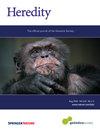Quantifying the effects of computational filter criteria on the accurate identification of de novo mutations at varying levels of sequencing coverage
IF 3.9
2区 生物学
Q2 ECOLOGY
引用次数: 0
Abstract
The rate of spontaneous (de novo) germline mutation is a key parameter in evolutionary biology, impacting genetic diversity and contributing to the evolution of populations and species. Mutation rates themselves evolve over time but the mechanisms underlying the mutation rate variation observed across the Tree of Life remain largely to be elucidated. In recent years, whole genome sequencing has enabled the estimation of mutation rates for several organisms. However, due to a lack of community standards, many previous studies differ both empirically – most notably, in the depth of sequencing used to reliably identify de novo mutations – and computationally – utilizing different computational pipelines to detect germline mutations as well as different analysis strategies to mitigate technical artifacts – rendering comparisons between studies challenging. Using a pedigree of Western chimpanzees as an illustrative example, we here quantify the effects of commonly utilized quality metrics to reliably identify de novo mutations at different levels of sequencing coverage. We demonstrate that datasets with a mean depth of ≤ 30X are ill-suited for the detection of de novo mutations due to high false positive rates that can only be partially mitigated by computational filter criteria. In contrast, higher coverage datasets enable a comprehensive identification of de novo mutations at low false positive rates, with minimal benefits beyond a sequencing coverage of 60X, suggesting that future work should favor breadth (by sequencing additional individuals) over depth. Importantly, the simulation and analysis framework described here provides conceptual guidelines that will allow researchers to take study design and species-specific resources into account when determining computational filtering strategies for their organism of interest.

量化计算筛选标准对在不同测序覆盖率水平上准确识别新突变的影响。
自发(新生)种系突变率是进化生物学中的一个关键参数,影响遗传多样性并促进种群和物种的进化。突变率本身随着时间的推移而进化,但在整个生命之树中观察到的突变率变化的机制在很大程度上仍有待阐明。近年来,全基因组测序已经能够估计几种生物体的突变率。然而,由于缺乏社区标准,许多先前的研究在经验上-最值得注意的是,在用于可靠地识别新生突变的测序深度-和计算上-利用不同的计算管道来检测种系突变以及不同的分析策略来减轻技术伪像-使得研究之间的比较具有挑战性。以西方黑猩猩的谱系为例,我们在这里量化了常用的质量指标的影响,以可靠地识别不同水平测序覆盖率下的新生突变。我们证明,平均深度≤30X的数据集不适合检测新生突变,因为假阳性率很高,只能通过计算过滤标准部分减轻。相比之下,更高覆盖率的数据集能够以较低的假阳性率全面识别新生突变,除了测序覆盖率的60X之外,收益最小,这表明未来的工作应该更倾向于广度(通过测序额外的个体)而不是深度。重要的是,这里描述的模拟和分析框架提供了概念性指导方针,允许研究人员在确定他们感兴趣的生物的计算过滤策略时考虑研究设计和特定物种的资源。
本文章由计算机程序翻译,如有差异,请以英文原文为准。
求助全文
约1分钟内获得全文
求助全文
来源期刊

Heredity
生物-进化生物学
CiteScore
7.50
自引率
2.60%
发文量
84
审稿时长
4-8 weeks
期刊介绍:
Heredity is the official journal of the Genetics Society. It covers a broad range of topics within the field of genetics and therefore papers must address conceptual or applied issues of interest to the journal''s wide readership
 求助内容:
求助内容: 应助结果提醒方式:
应助结果提醒方式:


